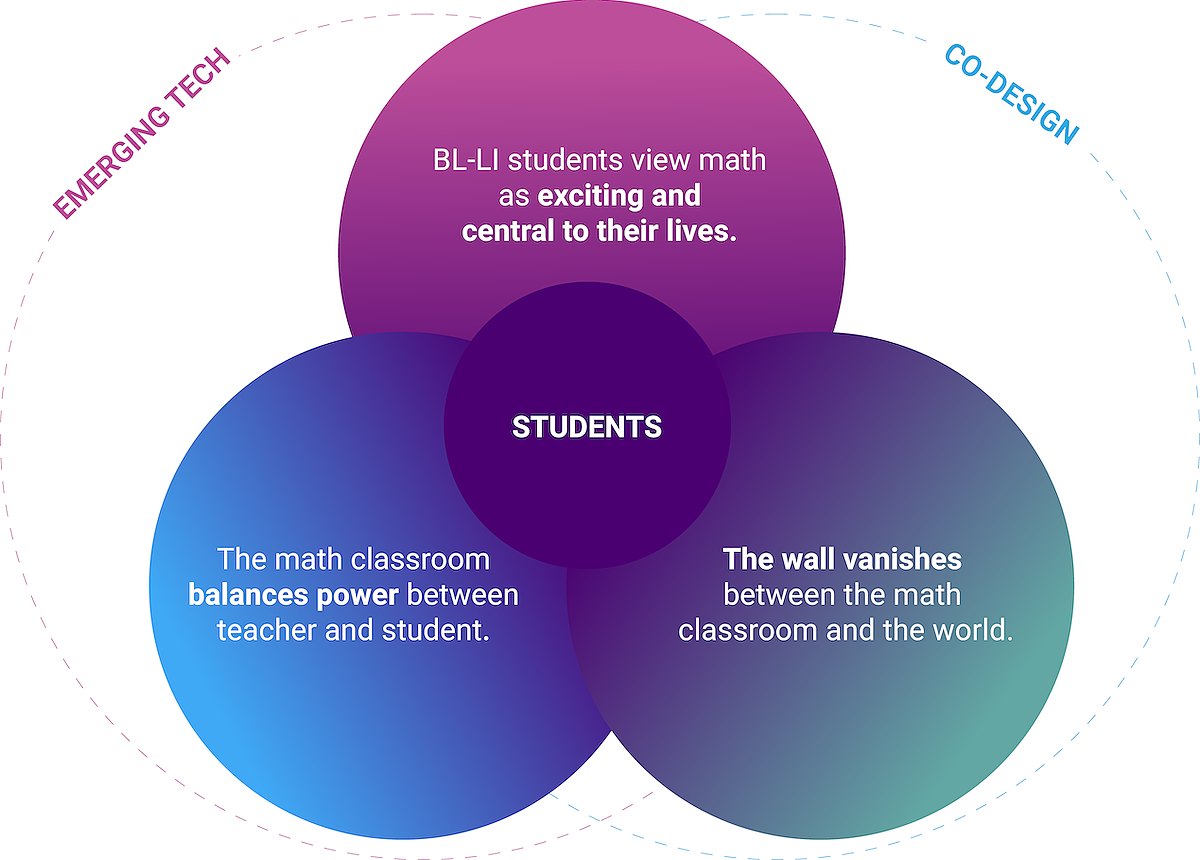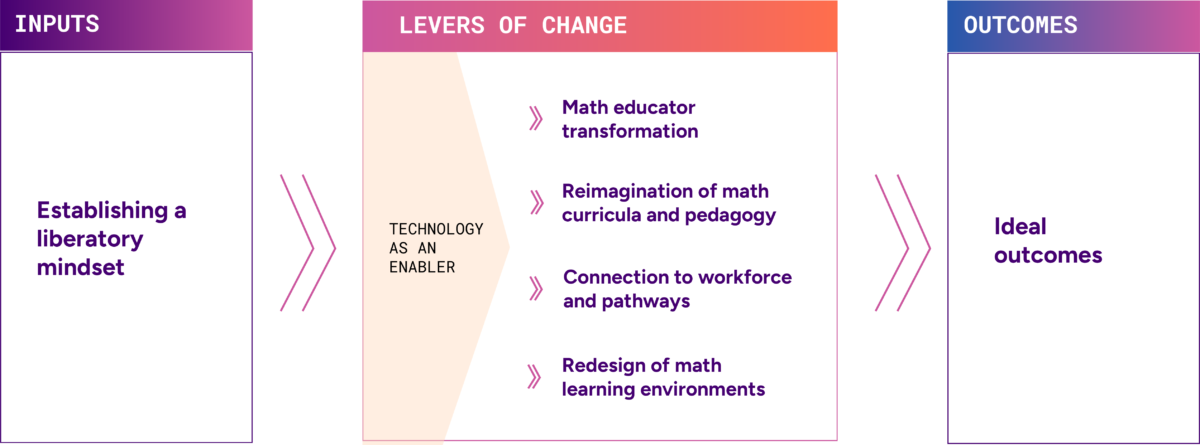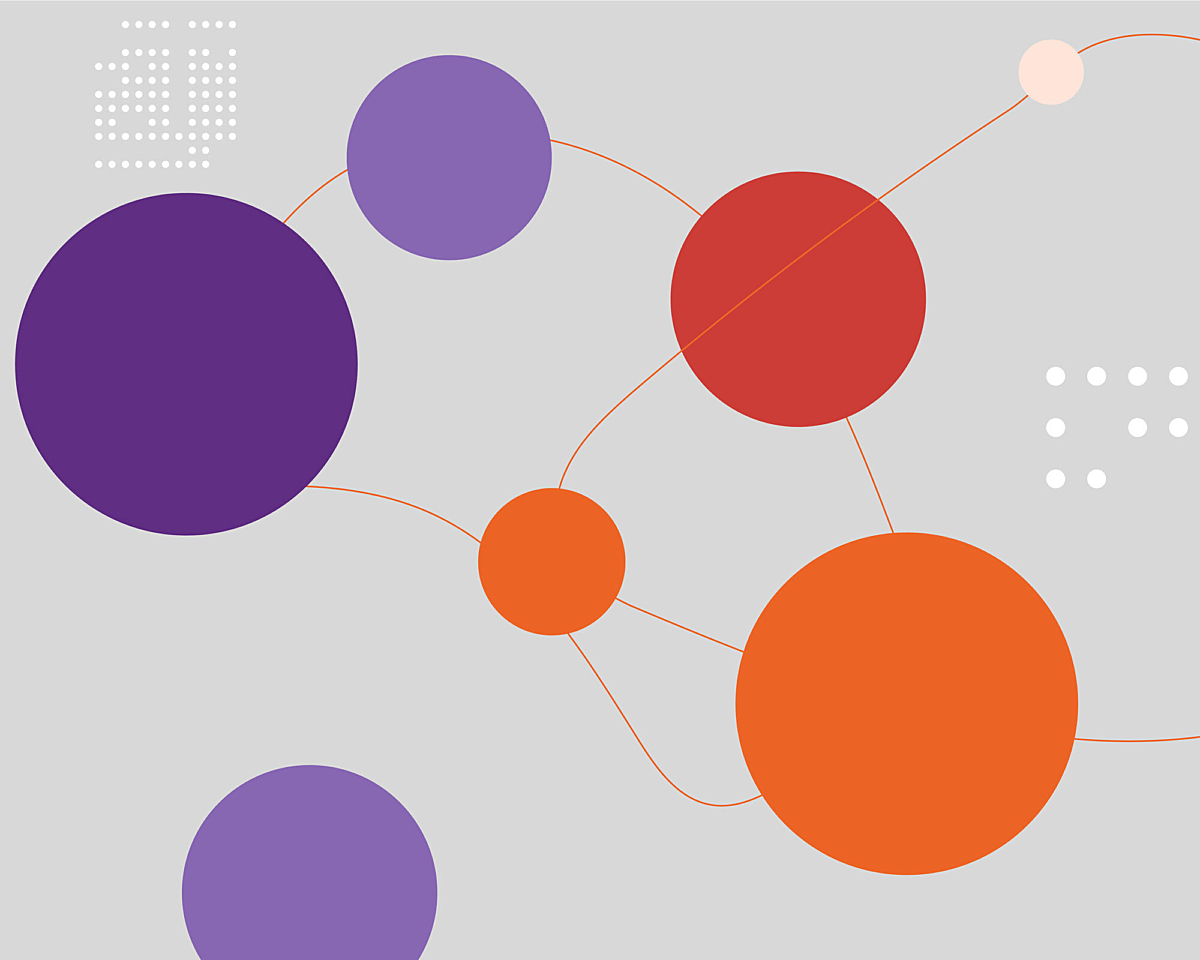Design Research
The Future of Math is Liberatory: Here’s How We Get There

Charting the path towards ideal math futures requires principled tech development, co-design with students, and collective action.
Close your eyes and imagine some of the most important developments in recent history. The COVID-19 vaccine. Artificial intelligence. Climate science. Quantum computing. All of these advancements have something in common: they require math knowledge and expertise. Math plays a critical role in our society today and will continue to be a radically important tool in developing futures where students, teachers, and caregivers use math to thrive.
Optimistic Design, in partnership with KnowledgeWorks with support from the Bill & Melinda Gates Foundation, kicked off the Modernizing Math project in which we used participatory design with lived experts—students, teachers, and caregivers—to Imagine a new path for the future of math education. They imagined a future where students and teachers share power, schools are re-designed to embrace the world, and students are excited to use and expand their engagement with their math education. We describe this future as liberatory: no student is marginalized and all students can thrive.
This project is intended to spark new conversations about what the future of math could look like. By leveraging future casting techniques utilized by KnowledgeWorks and anchoring on their drivers of change—which you can read more about in their companion piece: “Future Affecting Math Education: Widening the Lens of Change”—we gain a holistic perspective on the potential changes that are expected to impact our collective futures.
In our thought-provoking document, Modernizing Math: Envisioning Liberatory Math Futures, we aim to bridge ideas of where possible futures are headed, as well as share actions for policymakers, education leaders, technologists, and other stakeholders to make that vision a reality.
The Current State of Math Education
Historically, the field of mathematics has been inaccessible to Black, Latine, and low-income students, creating societal assumptions about who is a “math person.” These prevailing stereotypes have shaped a system of math education that feels irrelevant to students, prioritizing rote memorization and achievement on assessments over conceptual mathematical problem-solving. Students need to be prepared to face future challenges head-on: climate change, demographic shifts, technology advancements, and other factors. Having full access to math in their toolkits as designers of the future prepares students to be resilient through change.

The Future Vision for Math Education
Lived experts shared a vision of the future of math education that was joyful, collaborative, and engaging. They imagined a world where math felt relevant, providing students and teachers with new spaces to explore concepts together. In this world, caregivers and working practitioners in various career fields were also important stakeholders, taking part in math education by sharing their experience, expertise, and guidance as students navigated new problem spaces.
- BL-LI students view math as exciting and central to their lives.
Students will learn and apply math to a variety of contexts that encourage complex problem-solving. Students will engage in productive struggle when learning new concepts in math and are supported to reach new conclusions and discoveries.
- The math classroom balances power between teacher and student.
Teachers and students will regard one another as co-collaborators on the path to learning, creating safe spaces to explore math together. While students are given the autonomy to explore their interests in math, teachers will have the space to shift their strategies to support individual student needs.
- The wall vanishes between the math classroom and the world.
Students will connect math with their passions, exploring areas of interest and potential career opportunities. They will have support from their educators caregivers and practitioners in the field who can support their learning with apprenticeships and other learning opportunities.
Harnessing Emerging Technologies
To harness the power of emerging technologies, such as AI, AR/VR, blockchain, and those to come, we must create principles that technologists can use when developing new technologies. These principles ensure the safety of products that go to market but help develop trust and a sense of agency with the future students, teachers, and caregivers who will become co-designers. In the document, each principle also includes a series of prompts to consider while using or creating emerging tech.
- Principles for Development
Co-Design and Transparency: Technology needs to be created and developed in a community with those most marginalized within the system.
- Principles for Use
Creativity: Technology should diversify ideas and promote creative thinking.
Active Learning: Technology should prioritize inquiry-based learning and productive struggle.
Human Relationships: Technology should enhance and prioritize human relationships.
Data Autonomy: Data collection practices should prioritize the autonomy and consent of students.

Levers for Change
To initiate and sustain the transformational change necessary for a liberatory math future, we have identified several levers that can be activated to move us forward. Below is an abridged list of the levers for change—the full document includes these levers and definitions, a detailed list of future state indicators of change, and actions that can be taken to influence change to create the liberatory math future that lived experts envisioned.
Math Educator Transformation
Transforming math teacher education through training, support, and providing resources for teachers and other support educators as they engage with students and the education system at large.
Connection To Workforce and Higher Education Pathways
Developing relevant experience opportunities that involve mathematical reasoning that students can use to create or find opportunities to thrive in the future they will experience.
Reimagination of Math Curricula and Pedagogy
Developing a math curriculum that grows students' critical consciousness through supported and evolved teacher pedagogical practices that are focused on learning together.
Redesign of Math Learning Environments
Designing flexible learning environments that give students and teachers more opportunities to integrate math as an explorative practice.
How to Take Action Today
There are infinite possibilities for the future, whether it be the development of a flying school bus or the creation of a personalized math tutor that lives in student’s pockets. To get to this future, we must first design it, and then empower the students of the future to continue designing it. The systems of math education employed in the United States today are not currently working for most students, but the future is in our hands.
Our available resources, technology, and knowledge to take action should also include lived experts’ ideal visions for designing that future. Utilizing technology principles and the levers for change, we invite conversation and action toward the next steps in building a math future where all students, teachers, and caregivers thrive.
At Optimistic Design, as individual designers, we arrived at the organization with our own versions of Equity-Centered Design mindsets, processes, and tools. We continue to learn and develop the practice within our organization. Many of our approaches are heavily influenced by our individual, lived experiences as designers with intersecting marginalized identities as well as racial and social justice movements, abolition, systems thinking, social work, disability activism, etc. We look to practitioners like Antionette Carroll, Liz Jackson, and Sasha Constanza-Chock who continue to integrate traditional design education and practices. We have valued and learned from the work of Design Justice Network and the Equity Design Collaborative.
Want to learn more about our Equity-Centered Design work? Contact us.
Let’s Design the Future of Learning, Together

